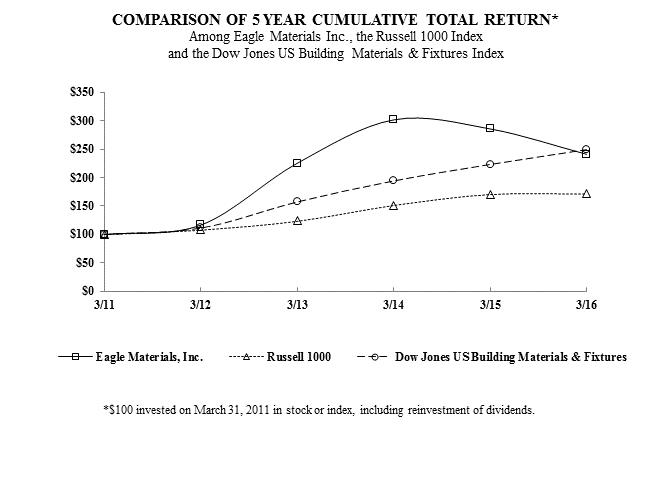Demand for gypsum wallboard continues to improve as well, as industry shipments of gypsum wallboard increased to 22.0 billion square feet in calendar 2015, compared to 21.5 billion square feet in calendar 2014, primarily due to the approximately 10% and 12% increase in single family and multi-family housing starts during calendar 2015 compared to calendar 2014.
Drilling and completion activity for oil and gas declined during calendar 2015, primarily due to the decrease in oil and gas prices during the year. The decline in oil prices adversely impacted drilling activity, which reduced demand for our frac sand products and oil well cement. This demand has also had a downward impact on the price of frac sand, which has declined since the peak in 2014. We do not expect any meaningful increase in oil and gas drilling activity during calendar 2016.
At March 31, 2016, we operated six cement plants (one of which belongs to our joint venture company), one slag grinding facility, sixteen cement distribution terminals, five gypsum wallboard plants, one recycled paperboard plant, seventeen concrete batching plants, four aggregates facilities, three frac sand wet processing facilities, three frac sand drying facilities and six frac sand trans-load locations. Our gypsum wallboard plant in Bernalillo, New Mexico has been idled since 2009. During the fourth quarter of fiscal 2016, we idled our Corpus Christi, Texas frac sand processing plant and our Kenedy, Texas and Fowlerton, Texas trans-load facilities, along with our Utica, Illinois frac sand mine. We intend to re-open the idled facilities when market conditions improve.
We continue to focus on growth through acquisitions or expansion of existing facilities that we believe provide an opportunity to realize an appropriate return on investment and create value for our shareholders.
On July 10, 2015, we completed the acquisition of a 0.6 million ton per year Granulated Ground Blast Furnace Slag (“Slag”) plant in South Chicago (the “Skyway Plant”) with Holcim (US) Inc. (the “Skyway Acquisition”). Among other applications, Slag is used in conjunction with Portland cement to make a lower permeability concrete. The Skyway Plant purchases its primary raw material, slag, pursuant to a long term supply agreement with a third party.
The purchase price (the “Skyway Purchase Price”) for the Skyway Acquisition was approximately $29.9 million, net of $2.5 million which will be refunded by the seller. We received $1.5 million of the expected refund in January 2016, and we expect to receive the remaining $1.0 million in January 2017. We funded the payment of the Skyway Purchase Price and expenses incurred in connection with the Skyway Acquisition with operating cash flow. We also assumed certain liabilities, including contractual obligations, related to the Skyway Plant.
On November 14, 2014, we acquired all of the outstanding equity interests of CRS Holdco LLC, CRS Proppants LLC, Great Northern Sand LLC, and related entities (collectively, “CRS Proppants”) (such acquisition, the “CRS Acquisition”). CRS Proppants is a supplier of frac sand to the energy industry, and its business currently consists of a frac sand mine in New Auburn, Wisconsin, and a trans-load network into Texas and southwest Oklahoma. The purchase price (the “CRS Purchase Price”) paid by the Company for the CRS Acquisition was approximately $236.1 million in cash, including approximately $8.9 million for in-process capital expenditures paid through the closing date, estimated working capital and other estimated closing amounts. This expansion was completed during the first quarter of fiscal 2016, at a cost of approximately $8.0 million.
Industry Segment Information
We currently have five different business segments, which are Cement, Concrete and Aggregates, Gypsum Wallboard, Recycled Paperboard and Oil and Gas Proppants. A description of these business segments can be found on pages 3-19.
We conduct one of our six cement plant operations through a joint venture, Texas Lehigh Cement Company LP, which is located in Buda, Texas. We own a 50% interest in the joint venture and account for our interest using the equity method of accounting. However, for segment reporting purposes, we proportionately consolidate our 50% share of the cement joint venture’s revenues and operating earnings, which is consistent with the way
